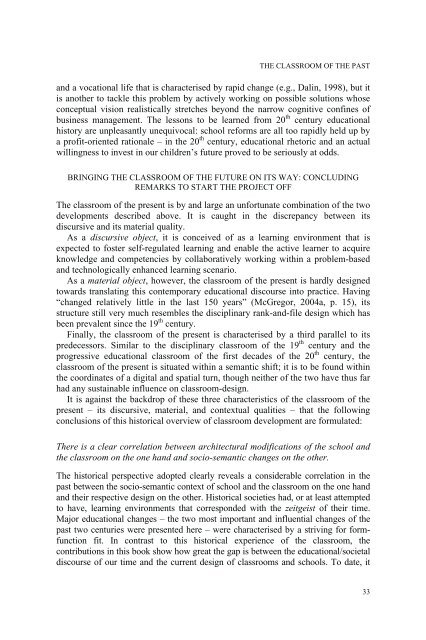Classroom of the Future - Sense Publishers
Classroom of the Future - Sense Publishers
Classroom of the Future - Sense Publishers
You also want an ePaper? Increase the reach of your titles
YUMPU automatically turns print PDFs into web optimized ePapers that Google loves.
THE CLASSROOM OF THE PAST<br />
and a vocational life that is characterised by rapid change (e.g., Dalin, 1998), but it<br />
is ano<strong>the</strong>r to tackle this problem by actively working on possible solutions whose<br />
conceptual vision realistically stretches beyond <strong>the</strong> narrow cognitive confines <strong>of</strong><br />
business management. The lessons to be learned from 20 th century educational<br />
history are unpleasantly unequivocal: school reforms are all too rapidly held up by<br />
a pr<strong>of</strong>it-oriented rationale – in <strong>the</strong> 20 th century, educational rhetoric and an actual<br />
willingness to invest in our children’s future proved to be seriously at odds.<br />
BRINGING THE CLASSROOM OF THE FUTURE ON ITS WAY: CONCLUDING<br />
REMARKS TO START THE PROJECT OFF<br />
The classroom <strong>of</strong> <strong>the</strong> present is by and large an unfortunate combination <strong>of</strong> <strong>the</strong> two<br />
developments described above. It is caught in <strong>the</strong> discrepancy between its<br />
discursive and its material quality.<br />
As a discursive object, it is conceived <strong>of</strong> as a learning environment that is<br />
expected to foster self-regulated learning and enable <strong>the</strong> active learner to acquire<br />
knowledge and competencies by collaboratively working within a problem-based<br />
and technologically enhanced learning scenario.<br />
As a material object, however, <strong>the</strong> classroom <strong>of</strong> <strong>the</strong> present is hardly designed<br />
towards translating this contemporary educational discourse into practice. Having<br />
“changed relatively little in <strong>the</strong> last 150 years” (McGregor, 2004a, p. 15), its<br />
structure still very much resembles <strong>the</strong> disciplinary rank-and-file design which has<br />
been prevalent since <strong>the</strong> 19 th century.<br />
Finally, <strong>the</strong> classroom <strong>of</strong> <strong>the</strong> present is characterised by a third parallel to its<br />
predecessors. Similar to <strong>the</strong> disciplinary classroom <strong>of</strong> <strong>the</strong> 19 th century and <strong>the</strong><br />
progressive educational classroom <strong>of</strong> <strong>the</strong> first decades <strong>of</strong> <strong>the</strong> 20 th century, <strong>the</strong><br />
classroom <strong>of</strong> <strong>the</strong> present is situated within a semantic shift; it is to be found within<br />
<strong>the</strong> coordinates <strong>of</strong> a digital and spatial turn, though nei<strong>the</strong>r <strong>of</strong> <strong>the</strong> two have thus far<br />
had any sustainable influence on classroom-design.<br />
It is against <strong>the</strong> backdrop <strong>of</strong> <strong>the</strong>se three characteristics <strong>of</strong> <strong>the</strong> classroom <strong>of</strong> <strong>the</strong><br />
present – its discursive, material, and contextual qualities – that <strong>the</strong> following<br />
conclusions <strong>of</strong> this historical overview <strong>of</strong> classroom development are formulated:<br />
There is a clear correlation between architectural modifications <strong>of</strong> <strong>the</strong> school and<br />
<strong>the</strong> classroom on <strong>the</strong> one hand and socio-semantic changes on <strong>the</strong> o<strong>the</strong>r.<br />
The historical perspective adopted clearly reveals a considerable correlation in <strong>the</strong><br />
past between <strong>the</strong> socio-semantic context <strong>of</strong> school and <strong>the</strong> classroom on <strong>the</strong> one hand<br />
and <strong>the</strong>ir respective design on <strong>the</strong> o<strong>the</strong>r. Historical societies had, or at least attempted<br />
to have, learning environments that corresponded with <strong>the</strong> zeitgeist <strong>of</strong> <strong>the</strong>ir time.<br />
Major educational changes – <strong>the</strong> two most important and influential changes <strong>of</strong> <strong>the</strong><br />
past two centuries were presented here – were characterised by a striving for formfunction<br />
fit. In contrast to this historical experience <strong>of</strong> <strong>the</strong> classroom, <strong>the</strong><br />
contributions in this book show how great <strong>the</strong> gap is between <strong>the</strong> educational/societal<br />
discourse <strong>of</strong> our time and <strong>the</strong> current design <strong>of</strong> classrooms and schools. To date, it<br />
33














